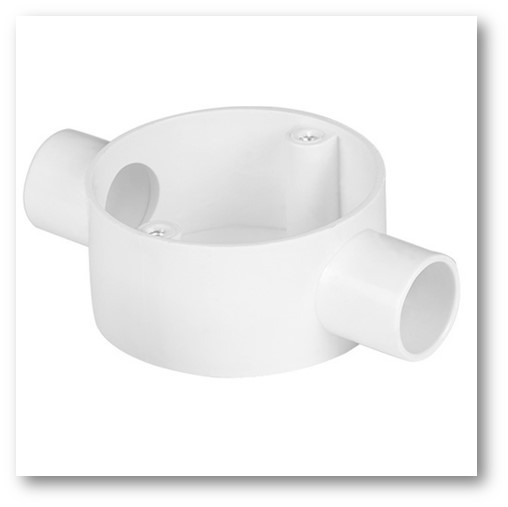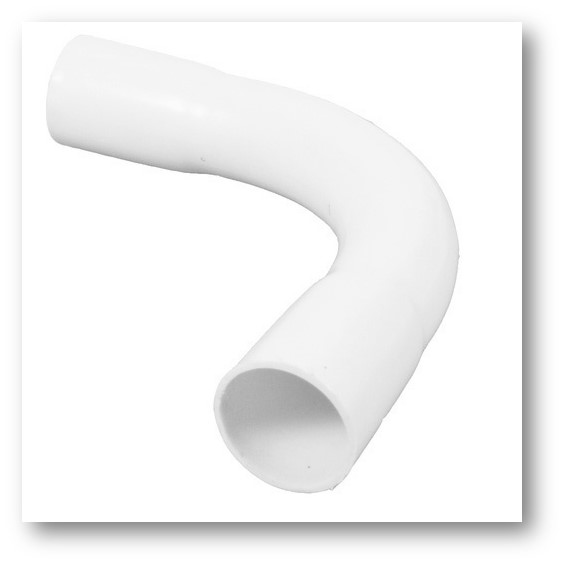In this wiring system the VIR wire or PVC wire run in the conduit pipe of different size as 0.75″, 1″, 1.25″, 1.5″, 2″ and 2.5″ etc. The conduits are electrically and mechanically continuous and are connected to earth at some suitable points to maintain the earth continuity throughout the installation. This wiring is of two types:
Surface conduit pipe wiring
In this system the conduit pipe is fixed on the wall or ceiling by means of the shaddles or clips. First, the conduit is fixed and then the wires are drawn. The earth wire is fixed by means of the earth clips. This type of wiring is suitable for factory or workshops etc.
Concealed conduit pipe wiring
In this system the conduit pipe (nowadays P.V.C. pipe is also used) is fixed under the wall or ceiling. In this case first the channels are made then the conduit pipe is fixed in the channel by means of hooks and clamps. Then the wires are drawn into the pipes.
As the wiring is done under the plaster so the whole of the system is made water tight to prevent the entering of moisture. The wires are drawn in the conduit pipe by means of either the drawing System or pushing or fish wire system.
There are the following advantages and disadvantages:
Advantages of conduit wiring
There are the following advantages:
- The wires are safe from mechanical damages. moisture and fire etc.
- The life is sufficiently long.
- Replacement of conductors, fault location and extension is easy.
- The wires of opposite polarity can run together in the same pipe.
- The wiring can be done in any places.
- If properly earthed this wiring is shock proof.
Disadvantages of conduit wiring
These are the following disadvantages:
- It is costly wiring than the cleat, batten and casing and capping wiring.
- It requires more skilled labour so labour cost is more.
- If the burrs are not removed these may spoil the conductor insulation.
- If not made properly water tight the moisture may enter and the insulation may damage.
General rules for conduit pipe Wiring
- The conduit pipe cutting should be done very carefully and the burrs should be removed with round file or reamer.
- The threading should be accurate for satisfactory joints. Apply oil while cutting threadings.
- In order to maintain good electrical continuity the threading should be painted with aluminium paint.
- The conduit pipe should be cleaned and there should not be any moisture or water drops etc. inside the pipe.
- First the pipe should be fixed on the wall or ceiling then the wires should be drawn with the help of draw wires.
- The pipe should be fixed with shaddles and the distance in no case, should exceed one metre. The wooden plugs should be used to separate pipe from a wall or ceiling.
- The conduit should be painted to save the pipe from rust etc.
- Use proper bushings at the end of the pipe where the wire leaves the pipe.
- Conduit should be electrically continuous and properly earthed.
- The conduit should be errected away from the water and gas pipe.
- The pipe should be water tight.
- The number of wires should be according to the diameter of the pipe. The over crowding should be avoided.
- The wires should not be in twisting form inside the pipe, avoid the possibility also.
- If pipe bending is essential use pipe bending machine.
- Use proper conduit pipe accessories for the wiring.
- The solid accessories should be used in case of concealed conduit pipe wiring and inspection accessories for surface conduit pipe wiring.
What are the common accessories used in conduit pipe wiring?
These are the following conduit accessories which are commonly used:
Conduit pipe: The conduit pipe which is used for wiring purpose is of two types:
- Light gauge: These are made from thin sheets of alloyed iron or aluminium or P.V.C. The two ends of these pipes are opened. Threading cannot be done over these pipes, because of less thickness. These are cheap but not suitable for good wiring.
- Heavy gauge: These pipes are either solid drawn or the ends are welded together. It is made of mild steel sheets. In this pipe threading can be done. It is painted to prevent the rusting. These pipes are commonly used. In case of PVC pipe the threading is not required our the housing is so moulded.
Flexible conduit pipe: It is usually called as flexible pipe. This pipe is used, where a rigid pipe cannot be used, e.g., near the terminal box of motors, generators, transformers etc. It is made of galvanised steel strips specially wound upon each other. These are available in different sizes as 20 mm, 25 mm, 31 mm, 38 mm, 50 mm, 56 mm, 69 mm, 75 mm etc. in diameter. PVC flexible pipes are also available of different diameter.
Couplings: These are used to join two conduit pipes in a straight line or this is used to couple two pipes together. Couplings are threaded in the inner portion to which conduit pipes are tightened.
Flexible coupling: It is used to join the flexible pipe where the wire leaves the rigid pipe. By using the flexible coupling, the insulation resistance of the wire is not damaged, while drawing the wires. These are made of wood, bakelite, cast iron. The iron bushings are threaded which serves as the lock nut.
Bushings: These are used at the mouth of the pipe, where the wires leave the pipe. It has two parts which can be joint together by means Of four screws.
Lock nuts or Check nuts: These are used at the end of conduit pipe entering the box. These are made of generally cast iron. One end of it clamps the flexible pipe, while the other end is threaded for check nut to fix with the box. These are available in different sizes according to the diameter of the pipe.
Conduit Nipple: These are same as that of the conduit bushings. These are used to increase the length of the conduit pipe and sometimes used to join elbow or two tees etc.
Conduit reducers: These are used at the places where a number of conduit specially two conduits of different diameters are joined.
Conduit boxes: These are used where a number of conduit pipes comes from different directions. These boxes are provided with covers, so it can be opened to inspect the wires. These are of different shapes: square, round, hexagonal or rectangular etc.
Junction boxes: These are used to join two conduit pipes. It has a cover to opening of which the wires can be drawn and inspected also as shown in Fig. 1. These are made of casted cast iron. These are two ways, three ways, four ways.

Fig. 1. Junction box.
T-solid or Inspection: These are used where the wires are to be brought down from the running line. The solid T is used in concealed conduit wiring and the inspection T, in the surface conduit pipe wiring, so that the wires can be inspected and drawn easily. These are available according to the diameter of the pipe.
Elbow or bend: These are used in the wiring, where the pipes are bend at 90°. These are made of cast iron or sometimes by simply bending the pipes. By the use of the inspection bend, the wires can be drawn and inspected also as shown in Fig. 2. These are available in according to the sizes of the pipes. P.V.C. elbow and bends of different diameters are available and used for wiring purpose.

Fig. 2. Conduit bend.
Conduit shaddles: The conduit pipe is fixed with the help of the conduit shaddles. Sometimes the shaddles are named as clamps, conduit straps. These are available in different sizes according to the pipe diameter.
Earthing clips: These are made of copper. These are fixed over the conduit pipe Wiring System having earth wire. These clips help in maintaining earth continuity throughout the installation.